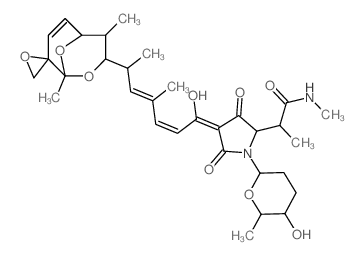7229-50-7
| Name | streptolydigin |
|---|---|
| Synonyms |
Antibiotic D-45
portamycin Streptolydigin 2-Pyrrolidineacetamide, 4-[6-(1,4-dimethylspiro[2,9-dioxabicyclo[3.3.1]non-6-ene-8,2'-oxiran-3-yl)-1-hydroxy-4-methyl-2,4-heptadienylidene]-N,.α.-dimethyl-3,5-dioxo-1-(tetrahydro-5-hydroxy-6-methyl-2H-pyran-2-yl)- |
| Description | Streptolydigin (Portamycin) is a 3-acetyltetramic acid antibiotic and a potent bacterial RNA polymerase inhibitor with a Ki of 18 μM and a Kd of 15 μM. Streptolydigin inhibits RNA synthesis by binding to RNA polymerase and does not inhibit eukaryotic RNA polymerases[1][2][3]. Streptolydigin possess potent antibacterial activity, particularly against anaerobes and some Gram-positive aerobes[4]. |
|---|---|
| Related Catalog | |
| Target |
Ki: 18 μM (Bacterial RNA polymerase)[3] Kd: 15 μM (Bacterial RNA polymerase)[3] |
| In Vitro | The antibiotic Streptolydigin (Stl) is a derivative of 3-acetyltetramic acid. Binding of Streptolydigin to RNA polymerase strictly depends on a noncatalytic magnesium ion which is likely chelated by the aspartate of the bridge helix of the active center[1]. Streptolydigin inhibits T. thermophilus RNA polymerase with a Ki of 1.8 μM[3]. Streptolydigin (Stl) inhibits initiation, elongation, and pyrophosphorolysis by bacterial RNA polymerase. Streptolydigin interacts with three structural elements within RNAP: the Stl pocket, the bridge helix, and the trigger-loop region. The Streptolydigin streptolol moiety interacts with the Streptolydigin pocket and bridge helix, and the Streptolydigin tetramic-acid moiety interacts with the trigger-loop region[3]. |
| References |
| Density | 1.3 g/cm3 |
|---|---|
| Boiling Point | 826.6ºC at 760 mmHg |
| Molecular Formula | C32H44N2O9 |
| Molecular Weight | 600.70000 |
| Flash Point | 453.7ºC |
| Exact Mass | 600.30500 |
| PSA | 147.16000 |
| LogP | 2.78890 |
| Index of Refraction | 1.598 |
CHEMICAL IDENTIFICATION
HEALTH HAZARD DATAACUTE TOXICITY DATA
MUTATION DATA
|
| Hazard Codes | Xi |
|---|
